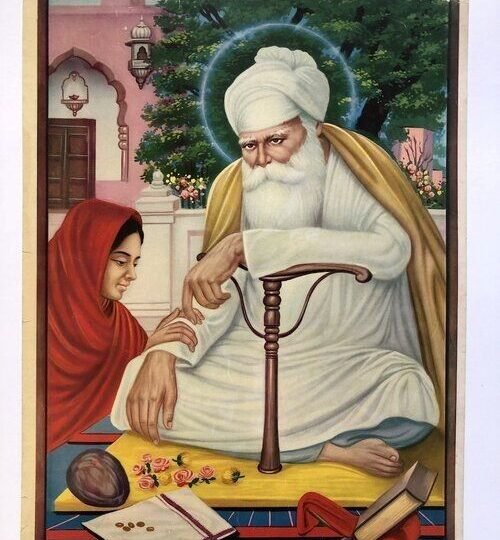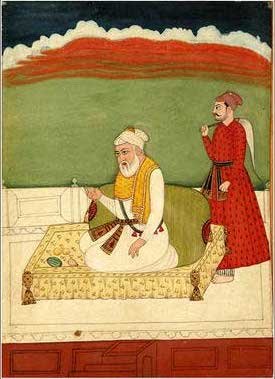Guru Amar Das Ji

Guru Amar Das (1479–1574)
Third Guru of Sikhism
Guru Amar Das (born 23 May 1479, died 1 September 1574) was the third of the ten Sikh Gurus and succeeded Guru Angad Dev Ji in 1552. Known for his deep devotion, humility, and organizational skills, Guru Amar Das greatly strengthened the Sikh community and institutionalized many key practices that define Sikhism today.
Early Life:
Guru Amar Das was born in the Khatri caste to Tej Bhan Bhalla and Bakhtri Ji in Basarke, a village near Amritsar, in the Punjab region. Like other Gurus, he was born into a Hindu family.
For much of his early life, Amar Das followed the traditional Hindu faith, going on numerous pilgrimages to religious sites, including Haridwar and the Himalayas, in search of spiritual fulfillment.
Spiritual Awakening
In 1539, at the age of 60, Amar Das had a turning point. He heard Bibi Amro, the daughter of Guru Angad Dev Ji, singing Guru Nanak’s hymns. Deeply moved, he asked her about the hymns and was introduced to Guru Angad, who he soon accepted as his spiritual master.
From that point, Amar Das committed himself to service (seva), including fetching water early in the morning, cooking meals, and cleaning for the community. Despite being older than Guru Angad, he served with humility and devotion for over 12 years.
Becoming the Guru
Impressed by his selflessness, Guru Angad Dev Ji appointed Amar Das as his successor in 1552, bypassing his own sons. He became the third Guru at the age of 73 and moved the Sikh centre to Goindwal Sahib, near Khadur Sahib.
Major Contributions
1. Langar System Expansion
Guru Amar Das formalized the langar (free kitchen) system. He made it mandatory for everyone—including kings—to sit together on the floor (pangat) before meeting him (sangat). This promoted equality and caste-less society, one of Sikhism’s core values.
2. Social Reforms
Guru Amar Das strongly opposed the caste system, sati (widow burning), female infanticide, and purdah (veiling of women). He empowered women by encouraging them to participate in religious and social life.
3. Preaching and Missionary Work
He divided the Sikh community into 22 manjis (dioceses), appointing both men and women as preachers to spread the message of Sikhism. This helped structure the growing Sikh population.
4. Pilgrimage Site – Goindwal Sahib
He established Goindwal Sahib as an important Sikh pilgrimage centre and dug the Baoli Sahib (a well with 84 steps). Devotees believe that bathing in the Baoli with devotion washes away sins.
5. Sikh Festivals and Scripture
He initiated the celebration of Vaisakhi as a religious festival and compiled hymns from Guru Nanak and Guru Angad, which were later included in the Guru Granth Sahib. He himself contributed over 900 hymns, primarily in the form of Saloks, Pauris, and Bani.
Relation with Emperor Akbar
The Mughal Emperor Akbar visited Guru Amar Das at Goindwal. Impressed by the langar system and Sikh principles, Akbar donated land for the construction of Gurdwaras and never imposed taxes on Sikh religious activities.
Spiritual Awakening
In 1539, at the age of 60, Amar Das had a turning point. He heard Bibi Amro, the daughter of Guru Angad Dev Ji, singing Guru Nanak’s hymns. Deeply moved, he asked her about the hymns and was introduced to Guru Angad, who he soon accepted as his spiritual master.
From that point, Amar Das committed himself to service (seva), including fetching water early in the morning, cooking meals, and cleaning for the community. Despite being older than Guru Angad, he served with humility and devotion for over 12 years.
Becoming the Guru
Impressed by his selflessness, Guru Angad Dev Ji appointed Amar Das as his successor in 1552, bypassing his own sons. He became the third Guru at the age of 73 and moved the Sikh centre to Goindwal Sahib, near Khadur Sahib.
Succession and Death
Following the tradition of spiritual merit, Guru Amar Das chose his son-in-law and disciple, Guru Ram Das, as his successor. Guru Amar Das passed away on 1 September 1574, at the age of 95, in Goindwal Sahib.
Legacy
Guru Amar Das strengthened the Sikh faith and gave it organizational structure, social equality, and spiritual discipline. His teachings laid the foundation for Sikhism as a distinct and progressive spiritual path, and his contributions remain vital to Sikh practice and identity today.

